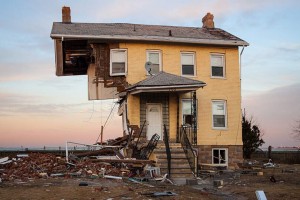.
From an Extensive Study by Sharon Kelly, Attorney & Writer, DeSmog News, January 21, 2020
Partially destroyed house in New Jersey after Hurricane Sandy
As 2020 begins, the impacts of climate change have become increasingly clear around the world. The new year started amid devastating wildfires, tied to the worst droughts Australia has experienced in hundreds of years, which encircled much of the continent. So far, 29 people have been reported dead. A University of Sydney professor estimated the number of animals killed likely tops one billion.
Today’s climate impacts have been shaped heavily by actions taken during the last 10 years, particularly in the U.S., where the climate benefits of coal power plant retirements were undermined by the rise of natural gas. Global carbon emissions had leveled off in the middle of the last decade, but began to climb again in 2017, breaking records anew each year since.
Over the past decade, as the climate crisis worsened, hundreds of drilling rigs dotted both the Permian Basin’s desert expanses in Texas and the Marcellus Shale’s Appalachian hills, grinding through rock to reach oil and gas trapped in brittle shale deep underground. In that time, the U.S. smashed global records for the production of oil and gas — two of the three fossil fuels most responsible for the ongoing climate crisis.
And at the same time, the last decade’s rush to drill continued to prove spectacularly unprofitable. The year 2020 arrived amid tens of billions of dollars in new fiscal write-downs and losses for oil drillers and fracking firms. Moody’s observed that oil and gas debt defaults represented 91 percent of the country’s total corporate debt defaults during the next-to-last fiscal quarter of the decade.
As the new decade starts, it’s worth taking stock of the last decade’s rush to drill and frack for oil and gas and to consider what we now know about how the costs of climate change have begun piling up at increasing rates over the past 10 or so years.
Climate Change Became a Huge Story
The 2010s brought evidence that even familiar principles of physics can operate in unfamiliar ways in a climate-changed world. In Phoenix, Arizona, June temperatures climbed so high that commercial airplanes were grounded amid concern that their wings could not generate the lift that makes manned flight possible.
The decade also saw some of the most catastrophic storms to ever strike along the Atlantic Coast, including four of the five most damaging hurricanes in U.S. history. “For all United States hurricanes, Katrina (2005) is the costliest storm on record,” a 2018 National Hurricane Center analysis found, using inflation-adjusted figures. “Hurricane Harvey (2017) ranks second, Hurricane Maria (2017) ranks third, Hurricane Sandy (2012) ranks fourth, and Hurricane Irma (2017) ranks fifth.”
As the decade ended, the deadly Hurricane Dorian — a storm so powerful some called for the Saffir-Simpson Hurricane Wind Scale to be extended to describe it as a “Category 6” storm — stalled over Great Abaco and Grand Bahama island with horrific consequences.
Between 1980 and 2019, climate and weather disasters wreaked billion-dollar damages 258 times in the United States, causing over $1.75 trillion in damages, NOAA reported this month. And those events are occurring more often. “2019 is the fifth consecutive year (2015-2019) in which 10 or more billion-dollar weather and climate disaster events have impacted the United States,” the agency wrote. “Over the last 40 years (1980-2019), the years with 10 or more separate billion-dollar disaster events include 1998, 2008, 2011-2012, and 2015-2019.”
Fourteen million people were impacted by the Midwest’s “great flood of 2019,” as the New York Times put it in September last year. That flood besieged those along the banks of the Mississippi for an even longer duration than the 1927 floods that led to laws giving the Army Corps of Engineers flood control authority over the river.
>>>>>>>>>>>>>>>>>>>>>>>>>
Industrial accident causes one man to be life-flighted; a second person injured
From a Local News Report, WTRF News 7, Wheeling, WV, January 22, 2020
Marshall County, W.VA. (WTRF)- Marshall County Chief Deputy Bill Helms says a water truck blew up — there was no well pad fire or explosion.
This occurred just off of Rines Ridge on Brian Drive around 11 am.
According to officials, one man was reported injured and life-flighted to an area medical facility.
UPDATE 12:04 PM: A second male has been injured due to the industrial accident. That person is being transported by ambulance to WVU Reynolds Memorial Hospital in Glendale, WV
The victims of the accidents were 26 and 23-year-old males.
Tug Hill is the operating company. And, the 911 call came in at 10:54 am

